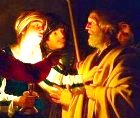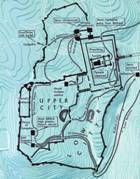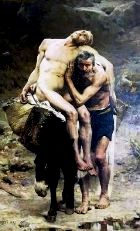Peter, apostle of Jesus
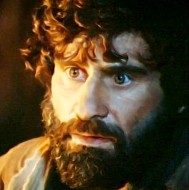 Peter was Jesus’ right-hand man, the disciple he relied on to pull the others into line.
Peter was Jesus’ right-hand man, the disciple he relied on to pull the others into line.
The reason? Peter was a born leader – energetic, confident, ready for whatever came his way. But careful too of the men around him, and loyal to the man he loved most, Jesus of Nazareth.
Jesus saw Peter’s worth. Saw all the faults as well, and accepted Peter as he was, knowing his heart was good.
Peter meets Jesus
Peter was an ordinary fisherman in Galilee, leading an ordinary life, but something quite out of the ordinary happened to him. He met a charismatic preacher called Jesus of Nazareth, and it changed everything.
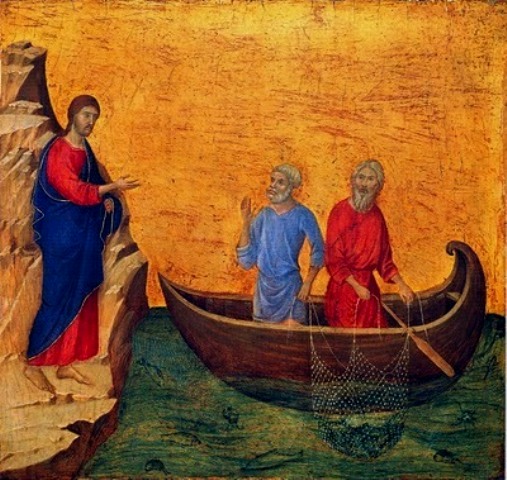 He was captivated by Jesus – by what he said, by his personality, by everything about him. Jesus was from the same modest background as Peter, and from a town even more nondescript – Peter came from Bethsaida. But he realized that everything else about this preacher was compelling, and he threw in his trade as a fisherman to follow him.
He was captivated by Jesus – by what he said, by his personality, by everything about him. Jesus was from the same modest background as Peter, and from a town even more nondescript – Peter came from Bethsaida. But he realized that everything else about this preacher was compelling, and he threw in his trade as a fisherman to follow him.
His parents had named him Simon or Simeon, but Jesus gave him a new name, a sort of nickname – Peter, which means ‘rock’.
His nickname was not too far from the modern name ‘Rocky’, and it sent the same sort of message: Peter was a solid no-nonsense man, a man you could trust. His father’s name was John, and we know that Peter married – there is mention of his mother-in-law, though none of his wife.
Peter, the man
Peter may have come from Bethsaida, but he and his brother Andrew lived in Capernaum and earned their living there by fishing. They were in partnership as fishermen with James and John, sons of Zebedee.
What sort of a man was Peter?
 Very human, like the rest of us. At times he was vacillating and unsure, as in his relations with the church of Antioch when he first ate with the Gentiles and then later on refused to do so; but he could also be resolute.
Very human, like the rest of us. At times he was vacillating and unsure, as in his relations with the church of Antioch when he first ate with the Gentiles and then later on refused to do so; but he could also be resolute.
Sometimes he was rash and hasty, irritable or even angry, but overall he was capable of great loyalty and love.
He seems to have been unlearned, in that he was not trained in the Mosaic Law. Almost certainly, he did not know Greek, which was the scholarly language of the day.
He was a slow learner, but when entrusted with responsibility he was mature and capable.
Peter as a Leader
From the start, he seems to have been the spokesman for the other disciples, the man who stood out from the group. In any list of disciples, Peter is always mentioned first, which seems to show he was Jesus’ right-hand man.
There are several incidents in the gospels that tell us about Peter the man, what he was like as a person.
- The first is his assertion that Jesus is the Messiah (Mark 8:29, Luke 9:20). ‘You are the Christ, the Son of the living God.’ Peter was aware of Jesus’ divinity, and blurted it out, demonstrating his faith and insight.
- He was impetuous by nature, a blurter: when Jesus said at the Last Supper that he would only accept as friends those whose feet he had washed, Peter told him to wash not only his feet but his hands and head as well.
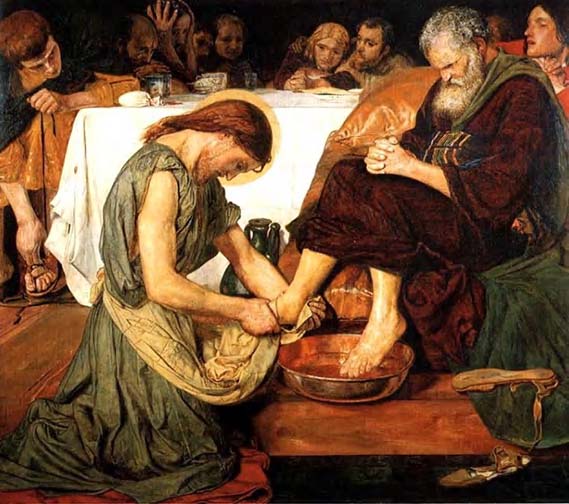
‘Christ Washing St. Peter’s Feet’, Ford Madox Brown.
The artist shows the psychology of each person – Peter’s grumpy acceptance of what Jesus has done, Jesus’ humility. Notice the figure of Judas at the corner of the table, stooping down to unloose his sandal.
- Another incident was when he denied that he knew Jesus, and this demonstrates something quite different: a failure of courage, even if only for a moment, in the face of danger – it had happened before, when Peter walked on water but then sank beneath the waves (Matthew 14:28-31).
But in both cases it was a short-lived lapse, and not a loss of faith in Jesus. Earlier, when Jesus had told Peter that he would deny him, Peter had indignantly refuted the idea and declared that, even if all the other disciples deserted Jesus, he would suffer death rather than disown his Lord.
But when the moment came, Peter had cut and run just as Jesus predicted: when confronted in the courtyard of the High Priest, he denied ever knowing Jesus.
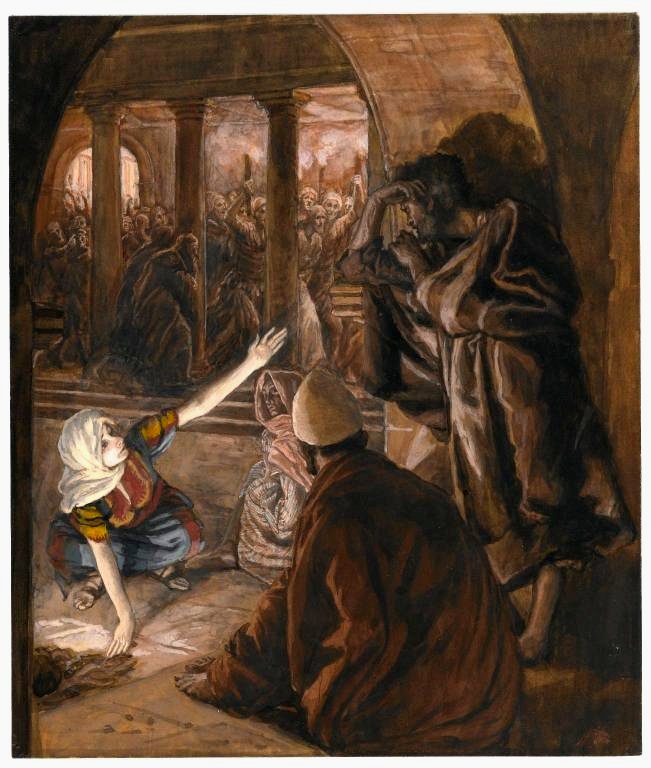
The third denial of Peter, and Jesus’ look of reproach, James Tissot
When he realized what he had done, and that Jesus had been right all along, Peter was deeply shamed, and wept bitterly. (Matthew 26:75; Mark 14:72)
Crucifixion – Did Peter see this?
Peter sees Jesus on Easter morning
Peter’s denial did not destroy Jesus’ trust in him. On the morning of the Resurrection, Peter was the first man to see Jesus – Jesus had already appeared to the women who came to the tomb at first light.
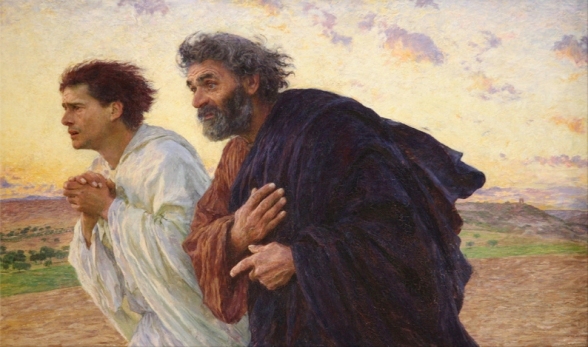
Peter and John run to the tomb on Easter morning, Burnand
After this, Peter emerged as the leader of the breakaway Jewish sect that became the early Church.
- Peter was the first to ‘raise his voice’ (Acts 1:14-39) and preach at Pentecost, the day when the Church came into being.
- He served as an advocate for the apostles when they were taken before the Jewish religious court in Jerusalem (Acts 4:5-22).
- He was the judge of contentious matters within the Church (Acts 5:1-10). All in all, he dominated the small but growing community of Christians in the first fifteen years after Jesus’ death.
The Raising of Tabitha, by Masolino de Panicale
Peter has the power to heal
Peter went to the Samaritans where he encountered the magician and faith healer Simon Magus; then he went to Lydda, where he healed the paralyzed Aeneas; and then at Joppa he raised Tabitha (Dorcas) from death, in the name of Christ (read her story here).
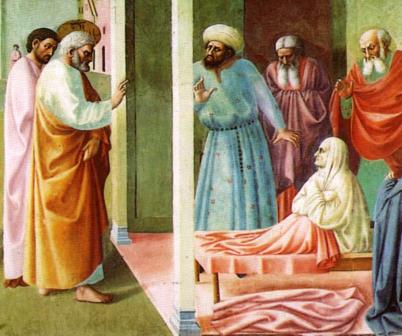
Masolino’s fresco of the Raising of Tabitha,
Cappella Brancacci, Florence
In the Mediterranean coastal city of Caesarea Peter introduced Gentiles into the community of Christians. At the time, a Gentile convert had to become a Jew through the rite of circumcision before they could become a Christian.
In accepting Cornelius and others without submission to circumcision, Peter introduced a practice that was to open up the Church to the Gentile population.
Peter was arrested and imprisoned, but was visited by an angel of the Lord, ‘and the chains fell off his hands’ so that he was able to escape (Acts 12:1-8).
Peter’s death
After he was imprisoned by Herod Agrippa (not to be confused with Herod the Great who was king when Jesus was born, or Herod Antipas who reigned at the time of Jesus’ ministry) Peter seems to have left Jerusalem and travelled to Rome.
There is nothing written in Acts about his stay in Rome, but there is a tradition that he died there, martyred by Nero on an inverted cross when he protested that he was not worthy to die in the way that Jesus had.
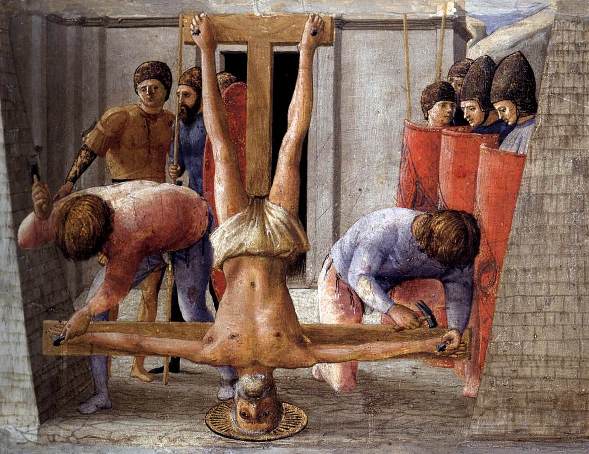
The martyrdom of St Peter, Masaccio
The painter shows Peter’s death with stark realism. The execution is taking place within a small courtyard, giving a sense of claustrophobia, especially as the soldiers crowd up against the executioners. The symmetry of the body seems to make it jump out at the viewer, giving the viewer the sensation we are witnesses of this grotesque death.
Search Box
![]()
© Copyright 2006
Elizabeth Fletcher


